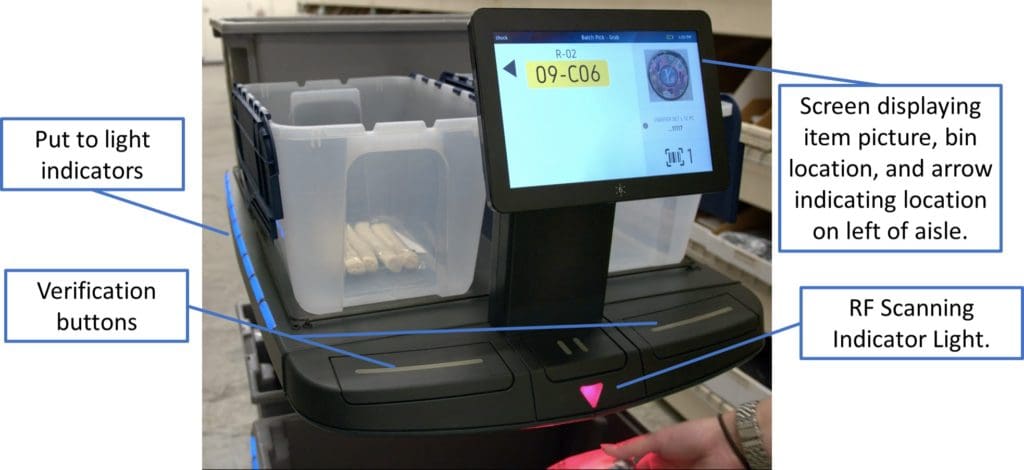ARC Advisory Group’s supply chain team believes that autonomous mobile robotics (AMR) in the warehouse is a high-growth and potentially transformative logistics technology. Therefore, we are devoting substantial effort into tracking the progress of the solutions within this rapidly developing market. On Friday, I had the pleasure of visiting 6 River Systems’ facility and receiving a personal demonstration of its collaborative autonomous mobile robotics system (AMR).
The 6 River Systems Solution
The 6 River Systems solution includes the company’s autonomous robots (named “Chuck”) and a cloud-based software solution that intelligently groups orders together to maximize task density and optimize worker productivity. The software solution also provides real-time robot fleet management capabilities and tracks activity such as worker-robot pairings, units per hour over the shift, and items that have been picked. The robots have 1500 square inches of work space and a maximum load of 160 pounds. The slots on the workspace can be configured a number of different ways to accommodate various operational needs. The robots collaborate with workers by guiding them through warehouse tasks. They facilitate induction and then lead associates through the picking process from bin location, item identification and confirmation, to job completion.
Chuck in Action
I received a live demonstration of Chuck in action at 6 River Systems’ facility. I met the robot at the induction location. The person responsible for induction scanned his badge with the RF scanner on the robot. The printer on the table nearby printed bar codes to identify the totes to be placed on the bot. This bot was configured for four half totes per level (eight total). The induction worker then scanned the bar codes and Chuck’s screen directed the worker to get half totes and displayed the surface area on Chuck where each tote should be placed. There are also lights on the side of the bot that lit up, indicating where to put the given tote. Two verification buttons on the back of the bot then lit up green, and the induction worker pushed the buttons to verify that the task of placing totes had been completed. Chuck then departed the induction station and traveled to the assigned location to meet the picking associate (this is typically at the end of an aisle).
We arrived at the meeting location and scanned our badge to register as the picker. The bot then immediately traveled toward the first pick location while its screen displayed a picture of the item to be picked, an arrow pointing to the side of the isle (left) where the item was slotted, and the bin number where the item is stored. Chuck then stopped about two feet beyond the picking location to accommodate the picker. I found these features to be especially useful for helping new workers, and others unfamiliar with the facility layout, to get up to speed quickly.
The red triangle shaped light on Chuck was flashing, indicating that the RF scanner below was ready. I easily located the correct bin, picked the item, and scanned it under the flashing triangle to confirm the pick. The green row of lights on the side of Chuck lit up on the perimeter to indicate the bin in which we were to put the item. At the same time, a wire frame image on the screen also identified the correct bin. We put the item in the bin and then pushed the green verification button to indicate that the pick was completed. The robot immediately began traveling to the next pick location, displaying an image of the next item, an arrow pointing to the side of the isle where the item was located, and the item’s bin number. This process repeated until we completed all picks associated with the job. At the conclusion of the last pick, we pushed the green verification button. Typically, at this point Chuck would provide instructions for the picker to proceed to a location where another Chuck would be waiting, then the full Chuck would proceed to a pack out station or to the next zone, depending on the process flow. In our case, Chuck began to travel to an area designated as the pack out station. I took this opportunity to step in front of the robot (in hindsight, I probably should have obtained consent to do so). The robot stopped, circumvented my location, and then proceeded to the pack out station. A worker would typically scan a badge at the pack station, then the lights on the side of the robot would be used to guide bin removals from the robot. This station at the 6 River facility was an unloading point, but it also served as the home base for the robot. An Apriltag on the wall enabled the robots to determine their current location in the facility. Once that is determined, the robots have the capability to infer the remainder of the layout from that primary point of reference.
Final Word
The 6 River System robots offer an intuitive design and guide workers to the correct locations and step them through the picking process at a granular level. The robots can clearly increase worker productivity and picking accuracy. 6 River Systems states that its offering can increase units per hour per employee by 200 – 300 percent. Pricing runs at about $250,000 for 8 robots in the first year and maintenance costs of about $50,000 a year thereafter. 6 River Systems currently has 10 customer sites with a total of more than 100 robots in use. It is the company’s end of year goal to have 600 Chuck robots in use across 30 sites.


















Leave a Reply